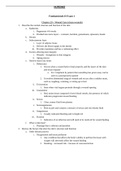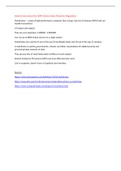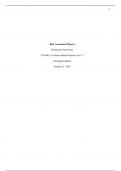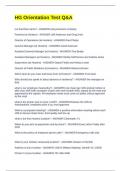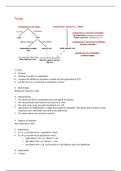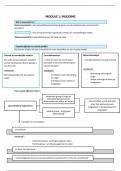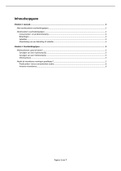Chapter 15, Arterial Disorders
Multiple Choice
Identify the choice that best completes the statement or answers the question.
1. A nurse hears a bruit while assessing the carotid artery of a client. Which is the most probable reason
behind the bruit?
1. Turbulent blood flow in the artery
2. Decreased blood flow in the artery
3. Problems in the tricuspid valve
4. Partial blockage of the aorta
2. The registered nurse is teaching staff nurses the relationship between cardiac output (CO), blood
pressure (BP), and peripheral vascular resistances (PVR). A nurse is asked to recap the mathematical
equation that relates the three factors. Which equation provided by the nurse indicates the need for
further teaching?
1. “CO PVR = BP”
2. “CO / BP = PVR”
3. “BP / PVR = CO”
4. “PVR / CO = BP”
3. The registered nurse is teaching a nursing student about the effects of glucose on the arteries. Which
statement made by the student nurse indicates effective learning?
1. “Increased serum glucosNeUcR
omSbIiN
neGs TwBit.
hCcaOrbMon dioxide and causes
atherosclerosis.”
2. “Increased serum glucose causes endothelial injury, which would lead to
atherosclerosis.”
3. “Increased serum glucose causes the breakdown of homocysteine and leads to
atherosclerosis.”
4. “Increased serum glucose increases blood pressure and damages the epithelium,
creating clots.”
4. The nurse is performing a physical assessment on a new client. The nurse notes diminished pulses,
palpable coolness, and pallor in the lower extremities. The client reports numbness, tingling, and
pain with ambulation. Which question by the nurse helps identify possible complications?
1. “Are you aware of changes in skin color?”
2. “Can you elevate your legs for pain relief?”
3. “Do you have pain when you rest your legs?”
4. “How would describe the temperature of your legs?”
5. Which is a risk factor for hypertension?
1. Increased vitamin C in the diet
2. Increased potassium in the diet
3. Insufficient sodium in the diet
4. Insufficient vitamin D in the diet
6. A registered nurse is preparing an in-service education session for nursing staff about the diagnostic
tests for cardiovascular diseases (CVDs). Which information does the nurse correctly include?
, 1. An elevated, high-sensitivity C-reactive protein (hs-CRP) indicates a low risk for
atherosclerosis.
2. Hypohomocysteinemia places a client at risk for developing atherosclerosis.
3. Hypothyroidism is a risk factor for atherosclerosis.
4. Twenty-four-hour urine analysis identifies contributing factors to atherosclerosis.
7. A client reports pain in the calf muscle while walking and exercising but also reports that the pain is
relieved by resting. Which medication does the nurse expect the health-care provider to prescribe the
client?
1. Pentoxifylline
2. Aspirin
3. Infliximab
4. Cyclophosphamide
8. Which clinical manifestation is observed in a client who has an abdominal aortic aneurysm (AAA)
rupture?
1. Increased blood pressure
2. Cool extremities
3. Hyperthermia
4. Decreased heart rate
9. A client has a pulsatile mass in the abdomen. Which assessment technique should be avoided until
the possibility of an abdominal aortic aneurysm (AAA) is ruled out?
1. Deep palpation of the abdomen
2. Auscultation of the abdoNmUeRnSfoIrNbG
ruT
itB.COM
3. Auscultation of the abdomen for bowel motility
4. Monitor level of consciousness and blood pressure
10. The nurse is caring for a client diagnosed with an aneurysm. For which diagnostic procedure,
prescribed to provide information about the size and location of the aneurysm, does the nurse
prepare the client?
1. X-ray
2. Magnetic resonance angiography (MRA) scan
3. Computerized tomography (CT) scan
4. Ultrasound of the abdomen
11. A client presents to the emergency room with reports of severe back pain described as a ripping
sensation. Further assessment reveals a different blood pressure in the right arm than in the left arm
of 20 mm Hg, generalized pallor, and tachycardia. Which possible condition causes the nurse to
immediately notify the health-care provider?
1. Myocardial infarction
2. Aortic dissection
3. Vasculitis
4. Mitral valve prolapse
12. The nurse is providing care to a client diagnosed with hypertension and scheduled for testing related
to the diagnosis. The client states, “I don’t know why I need to have kidney tests.” Which client
teaching does the nurse provide?
, 1. “The kidneys secrete hormones that cause vasoconstriction.”
2. “Circulation to the kidneys regulates sodium and water levels.”
3. “Stress triggers the kidneys to lower your blood pressure.”
4. “The ability of the kidneys to make urine is important.”
13. A registered nurse is teaching a nursing student the effects of medications that are used to treat
hyperlipidemia. Which statement of the student nurse indicates effective learning?
1. “Simvastatin blocks the absorption of fats from the intestine.”
2. “Cholestyramine blocks the bile acid absorption in the gastrointestinal (GI) tract.”
3. “Fenofibrate blocks the breakdown of fats in the tissues.”
4. “Ezetimibe increases the breakdown of bile acid absorption.”
14. A nurse is caring for a child diagnosed with Kawasaki disease who is exhibiting symptoms related to
the condition. Which symptom causes the nurse to be most concerned about the possibility of a
myocardial infarction (MI)?
1. Diarrhea
2. Joint pain
3. Abdominal pain and vomiting
4. Persistent fever
15. A child who has a fever of 103°F and diarrhea is admitted to the hospital. The parents state that the
child has poor oral intake and joint pain. The diagnostic test report shows that the child has an
elevated erythrocyte sedimentation rate (ESR) and a high platelet count. Which condition has the
child probably developed?
1. Kawasaki disease
2. Cryoglobulinemia
3. Raynaud’s disease
4. Wegener's granulomatosis
16. The nurse is providing teaching to a client diagnosed with hypertension. When the nurse presents
information about smoking cessation, the client states, “I don’t plan to quit unless someone
convinces me of the connection between smoking and high blood pressure.” Which information does
the nurse present?
1. Nicotine is a potent vasodilator of coronary arteries
2. Nicotine increases blood pressure by causing vasoconstriction
3. Significant remnants of nicotine remain in the body for 6 to 8 hours
4. Nicotine from smoking causes central nervous system stimulation
17. Which is the most common type of vasculitis of small-sized arterioles?
1. Raynaud’s disease
2. Polyarteritis nodosa
3. Temporal arteritis
4. Buerger’s disease
18. An older adult client reports severe headache, weight loss, fatigue, stiffness, and pain in the
shoulders. Which additional assessment finding does the nurse apply to specifically support a
diagnosis of temporal arteritis (TA)?
1. The client has a history of Chlamydia infections
Multiple Choice
Identify the choice that best completes the statement or answers the question.
1. A nurse hears a bruit while assessing the carotid artery of a client. Which is the most probable reason
behind the bruit?
1. Turbulent blood flow in the artery
2. Decreased blood flow in the artery
3. Problems in the tricuspid valve
4. Partial blockage of the aorta
2. The registered nurse is teaching staff nurses the relationship between cardiac output (CO), blood
pressure (BP), and peripheral vascular resistances (PVR). A nurse is asked to recap the mathematical
equation that relates the three factors. Which equation provided by the nurse indicates the need for
further teaching?
1. “CO PVR = BP”
2. “CO / BP = PVR”
3. “BP / PVR = CO”
4. “PVR / CO = BP”
3. The registered nurse is teaching a nursing student about the effects of glucose on the arteries. Which
statement made by the student nurse indicates effective learning?
1. “Increased serum glucosNeUcR
omSbIiN
neGs TwBit.
hCcaOrbMon dioxide and causes
atherosclerosis.”
2. “Increased serum glucose causes endothelial injury, which would lead to
atherosclerosis.”
3. “Increased serum glucose causes the breakdown of homocysteine and leads to
atherosclerosis.”
4. “Increased serum glucose increases blood pressure and damages the epithelium,
creating clots.”
4. The nurse is performing a physical assessment on a new client. The nurse notes diminished pulses,
palpable coolness, and pallor in the lower extremities. The client reports numbness, tingling, and
pain with ambulation. Which question by the nurse helps identify possible complications?
1. “Are you aware of changes in skin color?”
2. “Can you elevate your legs for pain relief?”
3. “Do you have pain when you rest your legs?”
4. “How would describe the temperature of your legs?”
5. Which is a risk factor for hypertension?
1. Increased vitamin C in the diet
2. Increased potassium in the diet
3. Insufficient sodium in the diet
4. Insufficient vitamin D in the diet
6. A registered nurse is preparing an in-service education session for nursing staff about the diagnostic
tests for cardiovascular diseases (CVDs). Which information does the nurse correctly include?
, 1. An elevated, high-sensitivity C-reactive protein (hs-CRP) indicates a low risk for
atherosclerosis.
2. Hypohomocysteinemia places a client at risk for developing atherosclerosis.
3. Hypothyroidism is a risk factor for atherosclerosis.
4. Twenty-four-hour urine analysis identifies contributing factors to atherosclerosis.
7. A client reports pain in the calf muscle while walking and exercising but also reports that the pain is
relieved by resting. Which medication does the nurse expect the health-care provider to prescribe the
client?
1. Pentoxifylline
2. Aspirin
3. Infliximab
4. Cyclophosphamide
8. Which clinical manifestation is observed in a client who has an abdominal aortic aneurysm (AAA)
rupture?
1. Increased blood pressure
2. Cool extremities
3. Hyperthermia
4. Decreased heart rate
9. A client has a pulsatile mass in the abdomen. Which assessment technique should be avoided until
the possibility of an abdominal aortic aneurysm (AAA) is ruled out?
1. Deep palpation of the abdomen
2. Auscultation of the abdoNmUeRnSfoIrNbG
ruT
itB.COM
3. Auscultation of the abdomen for bowel motility
4. Monitor level of consciousness and blood pressure
10. The nurse is caring for a client diagnosed with an aneurysm. For which diagnostic procedure,
prescribed to provide information about the size and location of the aneurysm, does the nurse
prepare the client?
1. X-ray
2. Magnetic resonance angiography (MRA) scan
3. Computerized tomography (CT) scan
4. Ultrasound of the abdomen
11. A client presents to the emergency room with reports of severe back pain described as a ripping
sensation. Further assessment reveals a different blood pressure in the right arm than in the left arm
of 20 mm Hg, generalized pallor, and tachycardia. Which possible condition causes the nurse to
immediately notify the health-care provider?
1. Myocardial infarction
2. Aortic dissection
3. Vasculitis
4. Mitral valve prolapse
12. The nurse is providing care to a client diagnosed with hypertension and scheduled for testing related
to the diagnosis. The client states, “I don’t know why I need to have kidney tests.” Which client
teaching does the nurse provide?
, 1. “The kidneys secrete hormones that cause vasoconstriction.”
2. “Circulation to the kidneys regulates sodium and water levels.”
3. “Stress triggers the kidneys to lower your blood pressure.”
4. “The ability of the kidneys to make urine is important.”
13. A registered nurse is teaching a nursing student the effects of medications that are used to treat
hyperlipidemia. Which statement of the student nurse indicates effective learning?
1. “Simvastatin blocks the absorption of fats from the intestine.”
2. “Cholestyramine blocks the bile acid absorption in the gastrointestinal (GI) tract.”
3. “Fenofibrate blocks the breakdown of fats in the tissues.”
4. “Ezetimibe increases the breakdown of bile acid absorption.”
14. A nurse is caring for a child diagnosed with Kawasaki disease who is exhibiting symptoms related to
the condition. Which symptom causes the nurse to be most concerned about the possibility of a
myocardial infarction (MI)?
1. Diarrhea
2. Joint pain
3. Abdominal pain and vomiting
4. Persistent fever
15. A child who has a fever of 103°F and diarrhea is admitted to the hospital. The parents state that the
child has poor oral intake and joint pain. The diagnostic test report shows that the child has an
elevated erythrocyte sedimentation rate (ESR) and a high platelet count. Which condition has the
child probably developed?
1. Kawasaki disease
2. Cryoglobulinemia
3. Raynaud’s disease
4. Wegener's granulomatosis
16. The nurse is providing teaching to a client diagnosed with hypertension. When the nurse presents
information about smoking cessation, the client states, “I don’t plan to quit unless someone
convinces me of the connection between smoking and high blood pressure.” Which information does
the nurse present?
1. Nicotine is a potent vasodilator of coronary arteries
2. Nicotine increases blood pressure by causing vasoconstriction
3. Significant remnants of nicotine remain in the body for 6 to 8 hours
4. Nicotine from smoking causes central nervous system stimulation
17. Which is the most common type of vasculitis of small-sized arterioles?
1. Raynaud’s disease
2. Polyarteritis nodosa
3. Temporal arteritis
4. Buerger’s disease
18. An older adult client reports severe headache, weight loss, fatigue, stiffness, and pain in the
shoulders. Which additional assessment finding does the nurse apply to specifically support a
diagnosis of temporal arteritis (TA)?
1. The client has a history of Chlamydia infections

